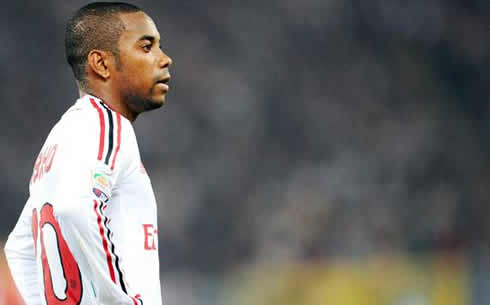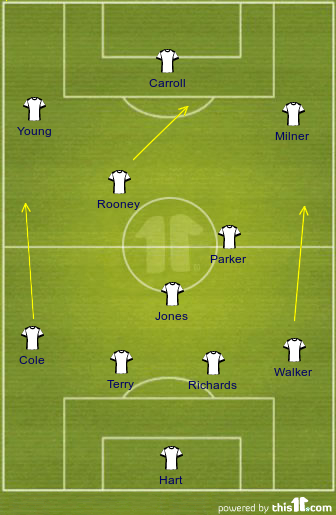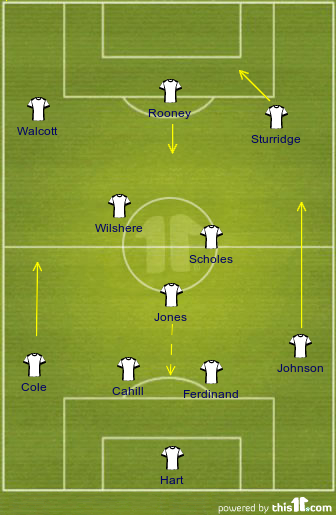This game won't go down as a classic between the sides, given some of the amazing results in the past, but there were some points of interest. A classic Italian shut-out that at times owed more to typically English traits of heroic last-ditch desperate tackles and blocks. Barcelona dominated possession and territory as expected, but were ultimately inefficient, and the tie is delicately balanced for the second leg.
By now, most football watchers with an interest in tactics will be well aware of the characteristics of these two teams. Milan typically play a very narrow midfield, and famously restricted Arsenal in the Gunners. Against Barca here they set out in an unsurprising 4-3-1-2 with Ibrahimovic starting with Robinho up front, former Portsmouth FA Cup winner Kevin Prince-Boateng as the trequartista and the usual array of grizzled campaigners behind them.
By now, most football watchers with an interest in tactics will be well aware of the characteristics of these two teams. Milan typically play a very narrow midfield, and famously restricted Arsenal in the Gunners. Against Barca here they set out in an unsurprising 4-3-1-2 with Ibrahimovic starting with Robinho up front, former Portsmouth FA Cup winner Kevin Prince-Boateng as the trequartista and the usual array of grizzled campaigners behind them.
Barcelona did spring one surprise, Keita starting in place of Cesc Fabregas, but apart from that alteration Guardiola too played as expected in a 4-1-2-2-1. Iniesta pushed up into Fabragas’ position wide left, as the more defensive-minded Keita took his place further back in midfield with Xavi.
There will come a point soon when Dani Alves will no longer be described as a defender, and the 4 at the base of Barcelona’s formation will become a more truthful 3. Alves played higher up the pitch than Busquets and Keita, and wider on the right wing than Iniesta was on the left. He was the only player giving real width to Barcelona’s attacks until the introduction of Tello in place of Iniesta in the 65th minute. On more than one occasion Milan were defending with 7 players within the width of the 18 yard box, and Alves was right there in acres of space waiting for the ball. He was passed to 74 times during the course of the game – more than Iniesta on the left and almost 30 times more than Keita who was playing in Iniesta’s usual position on the left of the midfield, within easy reach of Xavi.
The Xaviesta partnership was broken up, and it was Iniesta who suffered really, unable to influence the game to his usual extent.
For Barcelona, it was a night where nothing really clicked properly for them. Despite enjoying the larger slice of possession, a few of their attacks became pedestrian, and it seemed that what would normally be described as ‘patient build up’ looked more like a lack of a cutting edge.
The contrasting styles of the two teams are well illustrated in these representaitons of the passes played by each team into the final third. Milan played far more long balls up to Ibrahimovic, who to be fair is a fine target man. After judging the flight of the ball, he becomes an almost immovable object, and Milan searched for him as an outlet many times.
However, to describe the result as simply a failure of Barcelona clicking properly would be a disservice to a Milan side that defended heroically. Antonini and Ambrosini in particular showed such determination and spirit that Massimiliano Allegri couldn’t have asked for more. The same could not be said for Robinho, who squandered a gilt-edged chance to put Milan 1-0 up within three minutes of kick off, but skied his shot well over.
Milan’s front three pressed the Barcelona defence early on, but as the first half wore on Milan seemed content to allow Barcelona possession in non-threatening areas of the pitch. Ambrosini proved what a nuisance he can be with a huge performance, making six interceptions, 5 successful tackles and one block.
In total Milan made 25 interceptions compared to Barcelona’s 13. The spread of the interceptions shows that Milan were affecting a high pressing approach to defending.
Milan were very organised and efficient. Whilst sometimes happy to concede possession and territory, they put their foot in at vital moments to break down attacks. Most of the players will be straight into that ice-bath for a cool down after the game – a combination tactic of high pressing and packing the defence when Barcelona got close *and then* also counter attacking with gusto must’ve taken a lot out of the players, especially given their relatively high average age. Despite only having 35% of possession and 38% of territory, they managed to get as many shots on target as Barcelona - 3. Not including the five blocks put in by Milan defenders.
So whilst statistics will point out that Barcelona attempted more passes and achieved a higher percentage completion rate – the only real stats that matter at this point is 0-0; and Milan go to Camp Nou knowing that a score draw will see them though.
The stand-out moments of the game where the desperate and crucial blocks by Ambrosini and Antonini – but whether it’ll be those actions that are telling or the missed opportunities by their attacking colleagues will be worked out in two weeks’ time. Milan had far fewer chances, but they were perhaps the better ones.






















